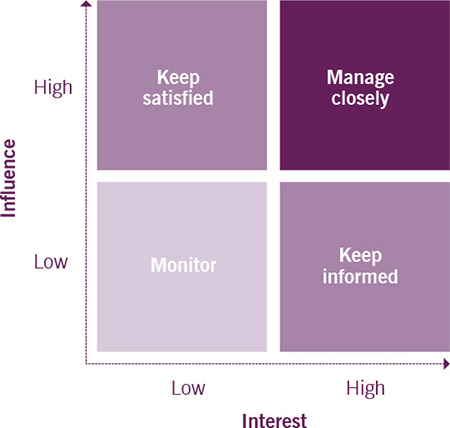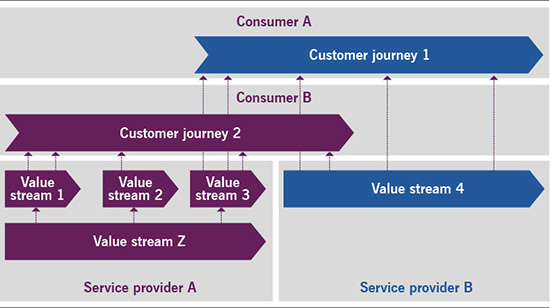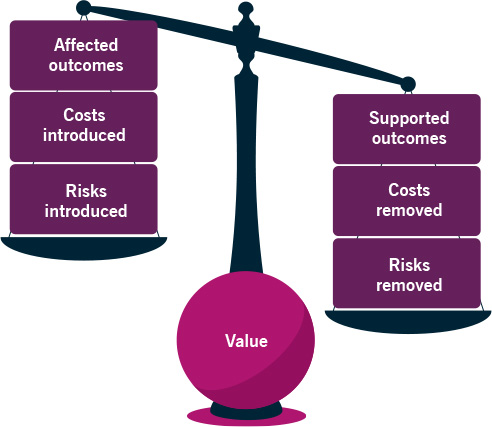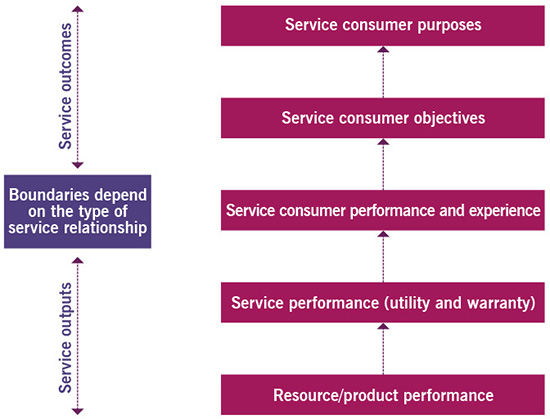CHAPTER 1
INTRODUCTION
1 Introduction
ITIL ® 4: Drive Stakeholder Value aims to guide stakeholders, whether they are customers or service providers, through the principles and practices of co-creating value through services.
Everyone contributes to value co-creation, including employees from large and small organizations, contractors, and customers. It is important to remember that this guidance is not prescriptive: not all of it will apply to everyone. Instead, it provides a framework for adopting and adapting to each individual situation.
This guide is written for individuals and organizations engaged in service relationships, including product and service provision, consumption, and relationship management. These are the people and organizations that are either involved in organizing the customer journey or taking part in it. The target audience includes, but is not limited to:
• relationship managers
• customer experience (CX) managers
• account managers
• service delivery managers
• service desk managers
• service level managers
• enterprise architects
• service and solution architects
• business analysts
• product owners and digital product managers
• marketing managers
• project managers
• portfolio managers
• supplier relationship managers
• vendor managers
• contract managers
• customer experience/user experience (UX) designers.
The guide assumes that the reader is familiar with ITIL Foundation, where the fundamental service management concepts of ITIL 4 are introduced.
1.1 The importance of engagement
Engagement is crucial to optimizing service value. This is because service value is always co-created by users, customers, sponsors, service providers, and any other parties involved in the service.
To drive stakeholder value, all stakeholders must contribute to the co-creation of service value. This publication will discuss the main steps of a customer journey, providing guidance on how to co-create the most valuable journey. The customer journey can be broken down into seven steps, which are shown in Table 1.1.
Table 1.1 The steps of the customer journey
Explore: understand markets and stakeholders |
The customer journey often begins before the service provider and service consumer have established a relationship. Both parties may explore their own needs and market opportunities for identifying partners that may contribute to the fulfilment of their respective needs. This exploration may include aspects such as operational context, strategic objectives, and organizational capabilities. |
Engage: foster relationships |
An important precondition for co-creating value through services is a functioning relationship between the service provider, service consumer, and other stakeholders. Good relations are a prerequisite for a cooperative relationship or partnership. |
Offer: shape demand and service offerings |
To determine whether the parties may benefit from a mutual service relationship, the service consumer and service provider should build a business case and articulate, shape, and match their demand and supply in the form of requirements and service offerings. Products and services can be designed only when the service consumer needs are well articulated and understood. |
Agree: align expectations and agree service |
It is crucial to align expectations, plan value co-creation and tracking, and agree service scope and quality before investing. |
Onboard: get on board or leave the journey |
Whether the parties came to an agreement or not, they must undergo a transition that involves the integration or separation of both parties’ resources. |
Co-create: provide and consume |
The service consumer makes use of accessible service provider resources, consumes the goods provided, and acts together with the service provider to co-create value based on the agreed service offerings. |
Realize: capture value and improve |
Value must be tracked and driven based on the value co-creation planning, and improvements must be applied to continually maintain and increase the service value. |
ITIL ® 4: Drive Stakeholder Value offers best-practice guidance for engaging in and contributing to each of these stages and can be used by anyone engaged in a service relationship, including service provision, service consumption, and relationship management.
1.2 Key principles
Service consumers and service providers are not the only people involved in the customer journey. There are many stakeholders who contribute to, benefit from, or influence the journey. These stakeholders may include owners, service provider employees, third-party suppliers, competitors, regulators, unions, industry organizations, communities, society, and others.
Services must create value for all relevant stakeholders. Therefore, it is important that all key stakeholders are identified and that relationships with the stakeholders are understood and managed.
One way to understand how each stakeholder affects, or may be affected by, the journey is to map the stakeholders in a matrix, categorized according to their influence and interest levels. Figure 1.1 shows an example of stakeholder analysis and mapping.

Figure 1.1 Sample stakeholder map
The stakeholders can then be managed according to their combined influence and interest, and can be kept satisfied, informed, and monitored with an appropriate level of communication. However, stakeholders and their influence and interest may change during the journey. For example, service providers may attempt to foster stakeholder interest and influence over time. This means that the stakeholder map should be revisited and amended regularly as the journey progresses.
In ITIL 4, the service consumer is an organization that consumes a service. In practice, there are at least three specific roles involved in the consumption of a service, which are shown in Figure 1.2 and include:
• the customer who defines the requirements for a service and takes responsibility for the outcomes of service consumption
• the user who uses the service
• the sponsor who authorizes the budget for service consumption.
These roles may be fulfilled by one or more people or teams, usually depending on the type and size of the consumer organization. In organizations where the roles are separate, communication and coordination are vital. To foster an effective service relationship between the service provider and the service consumer, it is necessary to invest resources in the coordination of both parties.

Figure 1.2 The three service consumer roles
In a service relationship, organizations will adopt the roles of service providers or service consumers. The two roles are not exclusive: organizations typically provide and consume a number of services at any given time. A service consumer can use its resources to create its own products to address the needs of another target consumer group and become a service provider. In this way, chains or networks of relationships may emerge, as shown in Figure 1.3.
The three fundamental service relationship types are shown in Table 1.2. Based on the strategies defined by the organization, a preference may be shown for one type of relationship over another.

Figure 1.3 The service relationship model
Table 1.2 Three fundamental service relationship types

The customer journey is the overall perception of the touchpoints and interactions between the service consumer and the service provider.
Table 1.3 outlines an example of a customer journey for resolving an incident from a user’s perspective.

Definition: Customer journey
The complete end-to-end experience that service customers have with one or more service providers and/or their products through touchpoints and service interactions.
Table 1.3 Example of a customer journey for resolving an incident
Roles |
Activity |
Customer journey |
User |
The user detects a malfunction in service operation. |
A service and/or the product malfunctions. The customer experience will be influenced by the specific situation, former incidents, etc. |
User Service desk agent |
The user contacts the service desk. The service desk agent performs ticket registration, adding available data to the record. The service desk agent performs the initial prioritization and triage of the ticket, confirming that the ticket does refer to an incident, and then informs the user of the priority and expected resolution time. |
The user contacts the service desk. The experience is good, based on the service desk agent’s attitude and behaviour. The user receives a message with the priority and expected resolution time. The priority and expected resolution time may be better or worse than expected. The user’s experience can also be affected by the historic degree of accuracy from the service desk. |
Service desk agent Second-line supporter |
The service desk agent performs an initial classification of the incident, which helps to qualify the incident’s impact, identify the team responsible for the failed components and/or services, and link the incident to other past and/or ongoing events, incidents, and problems. In some cases, classification helps to reveal a previously defined solution for this type of incident. If classification does not provide a solution, technical specialist teams perform incident investigation. This may involve escalating the incident between the teams or joint techniques, such as swarming. |
The user is waiting for a solution. |
Second-line supporter |
Technical specialist teams perform incident diagnosis and/or problem investigation, problem diagnosis, problem solution development, and problem resolution. When a solution is found, the relevant specialist team attempts to apply it. It may require the implementation of a formal change. If the solution does not work, additional diagnosis is performed. |
The user is waiting for a solution. |
Service desk agent User |
The service desk agent informs the user of the solution. User confirms service restoration. |
The service desk agent contacts the user to communicate a solution. The experience is based on the service desk agent’s attitude and behaviour, but also on the quality of the solution and whether the resolution time met or exceeded the previously announced resolution time. The user confirms or rejects the solution. The experience is formed by the effectiveness of the solution, how easy it is to validate, and how helpful the service desk agent is. |
User Customer |
The service is restored. The user can now work efficiently. |
The user continues working with the service and/or product. The experience is based on the solution’s usability and strength. |
User Service desk manager |
After the incident is successfully resolved, a number of closure procedures may be needed, including: • a user satisfaction survey • resolution costs calculation and reporting • resolution price calculation and invoicing • problem investigation initiation • incident review • updating and formal closure of incident record and related records. |
The user receives a satisfaction survey. Also, the user may receive a message that the incident has now been closed. The experience may be formed by the communication’s tone and comprehensiveness. |

Figure 1.4 Relationships between value streams and customer journeys
The relationship between value streams and customer journeys, as shown in Figure 1.4, can be characterized as follows:
• A customer journey always relies on at least one value stream from each of the involved parties.
• One value stream typically supports multiple customer journeys.
• One customer journey may span more than one service provider value stream or value streams from different service providers.
• The customer journey only includes value stream activities that are part of the band of visibility.
• Because organizations have value streams that are invisible to the other parties, some value streams will not be a direct part of the customer journey.
The customer journey rarely follows a pre-defined path. Sometimes the journey progress is straight from one touchpoint to the next, but most often a journey consists of going from one touchpoint to another and back again. The journey may also start in the middle of the expected path and then approach the expected starting point.
Customer and user journeys are important sources for customer and user experience (CX and UX). However, experiences are also influenced by factors in the environment, including the digital environment, and by the interactions and exposures that the consumer may have with the service provider’s brand. This includes deliberate communications from the service provider and communications and interactions that the consumers will have with the brand as part of everyday life.
Figure 1.5 illustrates the three aspects of the customer and user experience.

Figure 1.5 Three aspects of the customer and user experience

Definitions
• Customer experience The sum of the functional and emotional interactions with a service and service provider as perceived by a customer.
• User experience The sum of the functional and emotional interactions with a service and service provider as perceived by a user.
During a customer journey, there is a line of visibility beyond which customers cannot see the service provider’s activities. Similarly, there is a line of visibility beyond which the service provider cannot see the customer’s activities. This applies to internal and external customers and service providers.

Definition: Band of visibility
Activities and resources within a service relationship that are visible to both the service provider and the service consumer.
The band of visibility is where the service experience is formed. It includes the touchpoints, service interactions, and parts of the products and environment that are visible to more than one stakeholder in a service relationship. All parties need a clear understanding of the boundaries during the steps of the journey in order to understand how invisible elements influence the band of visibility and to ensure that everything within the band of visibility is properly managed.
Figure 1.6 illustrates the band of visibility.

Figure 1.6 The band of visibility
The band’s width depends on the nature of the service, the stakeholder relationships, and the journey’s degree of completeness. For example, if a customer consumes a simple commodity service, such as a standard server hosting in the cloud, the band of visibility will probably be quite narrow. However, if the customer and service provider enter into a long-term partnership, the band of visibility will probably increase because the parties will need a greater depth of understanding of each other’s activities in order to optimize the co-creation of value.
The ultimate purpose of the customer journey is to create value. Each step must add more stakeholder value than it deducts, whether in the step itself, in another step in the journey, or in a separate journey.
Throughout this guide, the description of each step of the journey will begin with an explanation of its purpose. A table will outline how each step is linked to the three aspects of value for the service consumer and the service provider. Value can never be created by the service provider alone; it must be co-created in a joint process between stakeholders. To succeed, service providers must actively interact with other stakeholders throughout the customer journey. Without interaction, there is no service. The interactions are called service interactions and are shown in Figure 1.7.

Figure 1.7 The customer journey and service interaction
Service value is subjective. Service outcomes must meet or exceed subjective stakeholder expectations and preferences for them to be considered valuable. These outcomes depend on the service’s performance, which includes service utility and service warranty.
Outputs are tangible and intangible deliverables that enable outcomes. For example, the outputs of a mobile phone service may include a telephone number, conversations with other people, text messages, and activity logging. For one customer, the perceived outcome may be closer relationships with people living abroad. For another customer, the same service may lead to an increased income resulting from successful sales conversations on the phone. People do not simply buy products or services, they pull them into their lives to make progress.1
Value leakage occurs when the full potential service value from fulfilling a need or exploiting an opportunity is not realized.2 Some causes of value leakage are:
• the relationship between service provider and service consumer is misaligned
• opportunities to create value are missed and products or services fail to completely satisfy the demands of the customer
• the service is provided or consumed sub-optimally
• value tracking and realization are lacking.
Outcomes require money, time, and resources. The total cost of a service is the sum of the money, time, and resources that stakeholders invest in service delivery and consumption. Figure 1.8 shows the three aspects of service value, where a perceived outcome is balanced against cost and risk.

Figure 1.8 Three aspects of service value
Additionally, outcomes may be subject to uncertainty and requirements imposed by other stakeholders. Because services are produced and consumed simultaneously, unexpected events may impact service consumption without warning. And because outcomes are normally achieved some time after customer needs are recognized, customer needs and conditions may have changed since the service relationship was established. There is, therefore, risk associated with both service consumption and outcome achievement. The level of risk depends on the amount of uncertainty (e.g. the threats, the vulnerability of the stakeholder at risk, and the impact on the stakeholder) and how far complying with the requirements imposed by other stakeholders affects the desired or expected outcome.
From a different perspective, a service relationship, by definition, implies the sharing of cost and risk. Service consumers typically reduce specific costs and risks by entering into a service relationship. Optimal service value is a balance between outcomes, costs, and risks, as illustrated by Figure 1.9.

Figure 1.9 Considering outcomes, costs, and risks to achieve value
The customer journey, including its touchpoints and service interactions, is an integrated part of the service. However, the service is different from and comprises more than just the journey. A service has to be scoped and defined so that all parties understand and agree to its goals and boundaries. Providers present their services to consumers in the form of service offerings, which describe one or more services designed to address the needs of a target consumer group. A service offering may include goods to be supplied to a consumer, access to resources, and service actions performed to address a consumer’s needs. Figure 1.10 shows how all these components relate to each other.
A product is a dynamic configuration of resources that is created by a service provider. A product can also serve as a resource for another product or a service. Products are typically complex and not fully visible to the service consumer. The portion of the product that falls within the band of visibility does not always represent the whole. Service providers define the line of visibility, which is tailored to their target consumer groups.
To summarize, a service implies the application of resources in the form of products and practices to enable outcomes through service offerings and service interactions. A simple value driver framework can explain how each layer in the service process drives value for the layer above. Figure 1.11 shows an example of a value driver framework.
Service performance drives service consumer performance: for example, the co-created outcome and experience. Service consumer performance drives the achievement of consumer objectives which fulfils the purpose of the service consumer.

Figure 1.10 How services, service interactions, service offerings, products, and resources are related

Figure 1.11 Example of a value driver framework
The ITIL story: A new service
|
Henri: Axle Car Hire’s vision is to be the most environmentally friendly car hire brand in the world. To achieve this goal, we are always looking for new areas where we can expand, and new services we can offer that are green and help support local initiatives. |
|
Radhika: When Axle decided to expand into South America, we did some in-depth research. In Brazil, recent improvements in socio-economic status have made car ownership desirable for many families. Cars are viewed as a prestigious purchase that offer an alternative to a busy public transport system. The infrastructure cannot support the demand for public transport, and there are limits to the number of people that commuter train lines and metro stations can carry. |
|
Solmaz: In recent years, Brazil has dramatically reduced taxes on electric vehicles, making them more economical for the average family. Some companies are already taking advantage of this by specializiwng in electric car hire. |
|
Henri: Our research showed that there was one group that was not well served by car hire: students! I wanted Axle to find a way to make sure students had affordable, eco-friendly modes of transport to get to and from campus, so we established a fund for student-led green transport initiatives. |
|
Radhika: Traditionally, Brazilian universities are funded by the government, significantly reducing education fees. This attracts students from all socio-economic backgrounds, some of whom commute daily to and from campus for more than two hours. |
|
Mariana: I applied for funding from Axle’s community grant. I was already researching the benefits and sustainability of long-term car-sharing for my PhD. With Axle’s funding, I can test the value, desirability, feasibility, and viability of a new service, eCampus Car Share. Many students would like the occasional use of a car without the costs of ownership, such as tax, insurance, parking, and maintenance. The scheme could also be offered to university staff, who would benefit from it as well. Under this scheme, electric cars will be available to all students and staff, reducing the number of cars on the roads and overall car emissions. |
|
Solmaz: Axle will support Mariana with the funding and expertise in service design and management that she needs to get her car share club started. |
|
Mariana: My vision for the car share club is that students and staff will buy a monthly membership. They will be able to book and collect electric cars on campus and pay only for the time they use them, at a reduced rate. They can return the cars to any charging station on campus, ready to be collected by the next customer. They will be able to search the exact locations of the cars via the booking app, and use a swipe card to open and start the car. I hypothesize, based on experiences around the world, that a car share service will result in fewer cars on the road, reduced greenhouse gas emissions, and a more efficient commute. Car share users frequently combine errands into one trip to maximize the availability of the vehicle they have hired. This will mean fewer car trips overall. |
|
Tomas: I specialize in human-centred design at the university. I am Mariana’s PhD supervisor, and I will ensure that value is co-created by including all stakeholders in the design of the service offering. The university will be involved in order to ensure parking, charging points, and access points for students and staff. |
